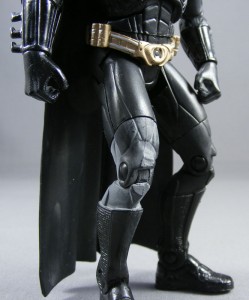I was digging out some of the DCUC and Movie Masters figures the other day and found several of them–particularly Deathstroke, Nightwing and Movie Masters Batman Begins Batman–were covered with that oily, misty substance. There was a lot of discussion of this after DCUC Wave 3–apparently the worst offender for this issue–and in doing some research, I came across this informative Fwoosh post by user BigGuido.
Now, I can’t vouch for the accuracy of his claims, but it sounds plausible, and it’s the closest thing I’ve ever read to a decent explanation of what’s going on.
On a side note, has anyone noticed this happening with any MOTUC figures? I haven’t yet, but I also haven’t been checking all that closely.
All plastics are petroleum derived products and as such they are sensitive to heat, cold and UV light. Plastic over time depolymerizes (i.e. decomposes) and becomes brittle and discolored. How long this takes depends on how and where you store the item and what the quality of the plastic was in the first place. Eventually, all of our collections of plastic toys are going to end up turning to crap. It is just a question of when.
The semi-flexible PVC that Toy Biz used for the majority of their LOTRs toys was pretty much standard stuff in the toy industry. Most of my figures have held up quite well, but I am pretty careful about storing them in a climate controlled area. Some of the stuff I have bought over the last few years, though has actually been degrading faster than older items. Most of the JLU figures I have bought as well as the DC Super Friends (both made by Mattel) have had severe chalking issues. This is a issue you run into with really cheap Polyvinyl Chloride (PVC). Chalking is the deterioration of the vinyl surface, thereby exposing the TiO2 particles to the surface. The white powder chalking that can be wiped from the surface of most vinyl is TiO2 particles mixed with deteriorating vinyl (PVC). TiO2 is titanium dioxide – a base pigment used in the manufacture of most PVC.
Back when I was living in my old house I had very limited storage save for an unfinished attic bedroom. This ended up being my toy storage area and I had a lot of problems like the one you are describing. Also, different kinds of plastics will react with each other when they come in contact due to the base solvents that are used in polymerizing the plastics. When these plastics interact, melting like what you described will occur. Styrene Plastic and PVC are two plastics that will do this to each other. If the knife sheath was made of styrene and the cape PVC then that could be what caused the melting. The best way to prevent this from happening again is to follow the advice I mentioned earlier and store the items seperately in plastic bags. Ziploc bags and their ilk are made from polyethylene plastic and they pretty much don’t react with the majority of plastics used in toy manufacturing. I believe a less flexible form of polyethylene plastic is used in making the blister and trays that most action figures are packaged in – but don’t hold me to that. It would make sense, though as it would be far less apt to react with the plastic used in the figure.
Realizing that our collections are all going to decompose into a pile of crap is a bit of a bummer, but being in my late 40s (I’m old chronologically, but still a kid at heart) if my collection can make it another 25 to 30 years then it will no longer be my problem – LOL! Seriously, it hasn’t been until the last 20 years or so that toy manufacturers actually started making an effort to manufacture toys that might last longer than 2 to 5 years. Before that, plastic toys were just cheap, disposable items that were meant to be played with and eventually tossed when the child broke or outgrew them.
On a positive note, polymer technologies have come a long way since I was a kid back in the 60s and 70s. UV inhibitors are a major advancement and keep a lot of plastics looking good as new for a decade or more rather than a year or two – of course this depends on the plastic’s quality and its exposure to UV light. Even then, ALL PLASTIC DECOMPOSES. It is just a matter of TIME.
BTW, One thing you might have noticed is that the chalking doesn’t show up on PVC parts that have been painted due to the paint actually protecting the vinyl from deteriorating. Go figure, just like the primary reason for painting your house is to protect it from the elements and keeping the underlying wood from rotting, the same holds true for your action figures. A quick fix for a chalking figure would be to get a can of matching vinyl spray paint (You can get this at most auto parts stores – I really like DupliColor Brand paint) and paint the coat with it (after removing it from the figure). You will most likely have to paint his arms as well to get them to match. Just use 3M Blue masking tape to cover the parts you don’t want painted, and go to town.
DO NOT USE ENAMEL BASED PAINTS ON YOUR FIGURES – it will NEVER DRY and you will have a sticky, nasty mess on your hands.
If spraying it is too much of a hassle, you can always use Testor’s Model Master Acryl Paint and a good sable brush to paint it by hand. I use Winsor Newton Series 7 brushes as they do the best job and lay down a really smoooooth stroke that leaves virtually no brush strokes when the paint drys.

